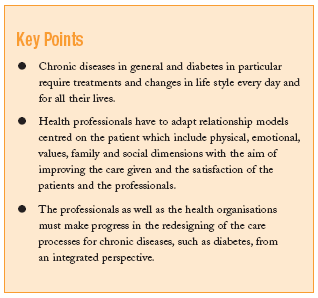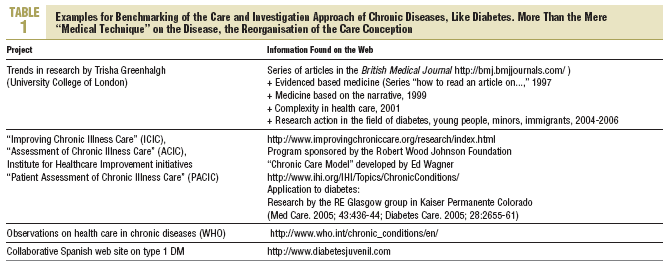The article by Escudero-Carretero et al,1 which presents a qualitative study on the clinical relationship in the context of insulin-dependent diabetes mellitus (DM), is timely and a guide to the direction that must be taken in the present and the future in the care of chronic diseases. Timely, because it directs us to a health problem which determines the life of those affected and their families and which does not fit well with functional clinical model, centred on the "technique," with risks of lack of continuity in care, or with a health system based on the "on demand" consultation, on the acute episode, on the doctor or on the hospital. A guide because it highlights facets centred on the patient and the carer (expectations, needs, opinions, emotions) and, therefore, value laden.
This study ratifies and confirms the urgency and the need to change the health care, both from the professional and institutional perspective, to take it more centred on the patient than a team, coordinated and in a process of continual improvement. A care which might incorporate and specify values which might promote coherent life styles and which is oriented towards self-care, to the self-management of the body and health. A care where the decision making is based on confidence and updated assessment which attempts to avoid uncertainty. In short, an integrated care which calls for, among its demands, that of rethinking and reformulating the therapeutic vehicle par excellence: interaction and clinical relationship.
Indeed, DM in general is a model of what chronic diseases signify for health care and society. DM is, without a doubt, a chronic, important and costly and disease which is reaching epidemic proportions. It is estimated that there are currently 194 million people in the world who have DM, which is 5.1% of the adult population, and this figure will increase 333 million (6.3%) by the year 2052. In a recent study carried out in the Autonomous Community of the Murcia Region3 indicated that an estimated 11% of the population é20 years had DM. The total prevalence of DM in the Murcia Region adjusted for the standard world population (30-64 years) is 7.6% (10.2% in males and 5.2% in females). Insulin dependent DM makes up between 5% and 10% of the cases diagnosed, and the age most affected is between 10-14 years. In Spain, the approximate incidence is 10-17 new cases/100 000 inhabitants/year.
Thus, DM is shown as a problem of considerable dimensions, particularly if we take into account its relationship with the increase in cardiovascular risk, the morbility and the complications in the short and long term which it involves. To have good control and treatment of the disease delays and reduces the appearance of these complications. The treatment of DM is one of the most complex, given that the patients have to combine medication, diet and exercise, throughout the day, dynamically and day in day out, permanently, for all their lives. To the drastic changes in the patients´ routine, is added the most common ways of administering the treatments and carrying out controls: the daily lacerations in the form of injections or pricks. All this very often means that therapeutic compliance is a challenge of the first magnitude. And this is even greater in the young patients, since the complexity and chronic nature of the treatment, added to the biological-social changes that occur during adolescence, makes it a very important challenge to the competence of the adolescent with DM, which
means that around 50% do not comply completely with their treatment.4
Despite all this being basically known by any primary care doctor, it is shocking that studies like that of Escudero et al continues to show the persistence of a care model which clearly does not help to confront the challenges which are involved in a disease like DM. Once again (how many times more do we need?), the "Godot" for which this is designed, is largely, our system of health care and for which, to a large extent, they prepare us in pre-grade and resident training, is not going to come. If the classic mid-xx century work of Samuel Becket, Nobel prize winner of Irish origin, characteristic of the theatre of the absurd, shows the futility of a chimeric wait and without direction, is it not equally inappropriate that health professionals should expect some rewards from some interventions which are weakly going to favour that which they ostensibly pursue?
We cannot ignore this reality, if we have a vision and some sketchy performances in a much more complex process and which requires us to work in various dimensions, between those which are unavoidable and that which incorporates the expectations of the patients and in relationship-communication context that is established with them and their care environments.
The psychologists Salvador and Melgarejo5 grouped the principal factors which can influence therapeutic compliance into 6 categories: factors associated with the disease (chronic nature, severity, stigma), with the treatment (administration, dosing regime), with the patient (age, belief, motivations, self-efficiency), with the doctor (empathy, communication strategy, values), with the patient-doctor interaction (type of relationship, control, making decisions, contact-empathy) and with the environment (family support and care environment). These same authors remind us that therapeutic non-compliance and its associated factors constitute a paradigmatic example of the failure of the traditional biomedical model to take into account the process of the disease and its impact in those affected by it. Timely and, as we said, in one of the suitable directions, Escudero et al confirm this insufficiency, which can be applied not only to the care of the insulin-dependent DM patient, but to all patients with chronic diseases. The participants in the mentioned study claimed something so "outrageous," like it should take them into account, that the health professional should centred on them as a person, in all their dimensions (physical emotional, intellectual and spiritual) and not simply a glucose value and the physical signs and symptoms. They demand health personnel who can empathise with their emotions, with their day to day difficulties to carry on with a "normal" life, that they are an emotional support throughout time, that they have the ability to communicate efficiently and therapeutically, that they teach them and motivate them, that they do not "tell us off" or threaten us, and that they recognise that they are experts, to a large extent, of their own disease and in the management of their own body.
How is it that, all too often, as health professionals as well as the health care system, we are inherently incapable of systematically integrating these so logical and so reasonable demands? How have we produced a health system which often shields us and prevents us from taking advantage of these "opportunities" which gives us the dynamics of a chronic disease extended throughout time? What else can emerge from the new Training Program of the Family and Community Medicine Speciality, which includes as essential competences, care communication and bioethics, together with the acquisition of clinical reasoning and care management?
Doctor-patient interaction is the principal determining factor of a wide range of factors associated with health intervention: information obtained in the interview, accuracy of the diagnosis, effectiveness of the consultation, compliance, the understanding of problems on the part of the patient and the satisfaction of the patient with the consultation, as well as that of the doctor too. However, the group of skills needed to improve this relationship, is not taught or practiced adequately in pre-grade, in resident training, or in continued education, which can have clear repercussions on patient care and on the job satisfaction of the doctor.
Twenty years ago, Jay Katz spoke of the paradoxical "silent world (or lack of communication) of the clinical relationship" as something that had to be reversed. All in all, things are changing. Today, after the pioneering efforts of the Communication and Health Group of semFYC (Family and Community Medicine) and numerous professionals from other fields and disciplines, it now cannot be said that there are no training (and to a lesser degree research) in aspects of communication and clinical relationships. Perhaps, that is not sufficiently generalised.
There also increasing initiatives in practical training in clinical bioethics such as, for example, that promoted by Bioethics Project for Clinical Practitioners of the Sciences and Health Foundation, led by Diego Gracia.
The focus on the essential competencies of the family doctor of the previously mentioned new training programme is welcome. But there is still much to do. It is good that some approaches are permeating little by little and at least they may become familiar: for example, the biopsychosocial model which George Engel pointed out almost thirty years ago, or "medicine centred on the patient" developed by McWhinney and Stewart, among others.
However, general systematic care practice, the "informal culture" of the organisation, is still a long way from moving into these parameters. These practices have still not been "automated", apart from those politically and healthily correct. For that reason, it is necessary not to give up on this line of work which Escudero et al point out. For that reason, it has to go deeper to confront the challenges that the chronic diseases create, from a professional as well as an interdisciplinary and institutional perspective, as regards care, but also in training and research.
We cannot ignore the path which is being opened up with examples (Table 1) like those of Trisha Greenhalgh of medicine based, at the same time and indissociable, on the "evidence" and on the narrative (quantitative and qualitative), which approaches the increasing complexity and what comes out of the health institution headquarters to go to the population. Or like the initiatives for improving the care of chronic diseases picked up by the Institute of Healthcare Improvement, driving force for the improvement of quality in the United States. Or like the initiative of the World Health Organisation which promotes the Chronic Care Model (CCM). With all these new work tools and new lines of investigation are emerging, not only descriptive, but of action, establishing, health services, such as the Assessment of Chronic Illness Care (ACIC) or the Patient Assessment of Chronic Illness Care (PACIC). In this sense, it is very illustrative and encouraging to go on the Internet and look at the quantity and quality in some cases, of the information it has on DM. The possibilities of the new technologies, far from "displacing" the professionals should be an opportunity to promote more and better informed patients. The health professionals have to be aware of this situation, in the extent of our possibilities, and orientate or patients towards using these resources. Some diabetic patients, experts in other areas of knowledge, have made this knowledge available to everybody and have created Web pages or computer programs which help in the control of the disease and provide information and support.6
We have, therefore an exciting path ahead to walk in the improvement in the care of chronic diseases in general, and DM in particular. A path to walk, but not to waste time in futile, and often, self-destruction (professional erosion), waiting like the protagonists Vladimir and Estragón, waiting in vain for Godot, but for both the professional and the institution to walk together. We have to continue along this path with good walking companions such as Escudero et al, who spread the example.











